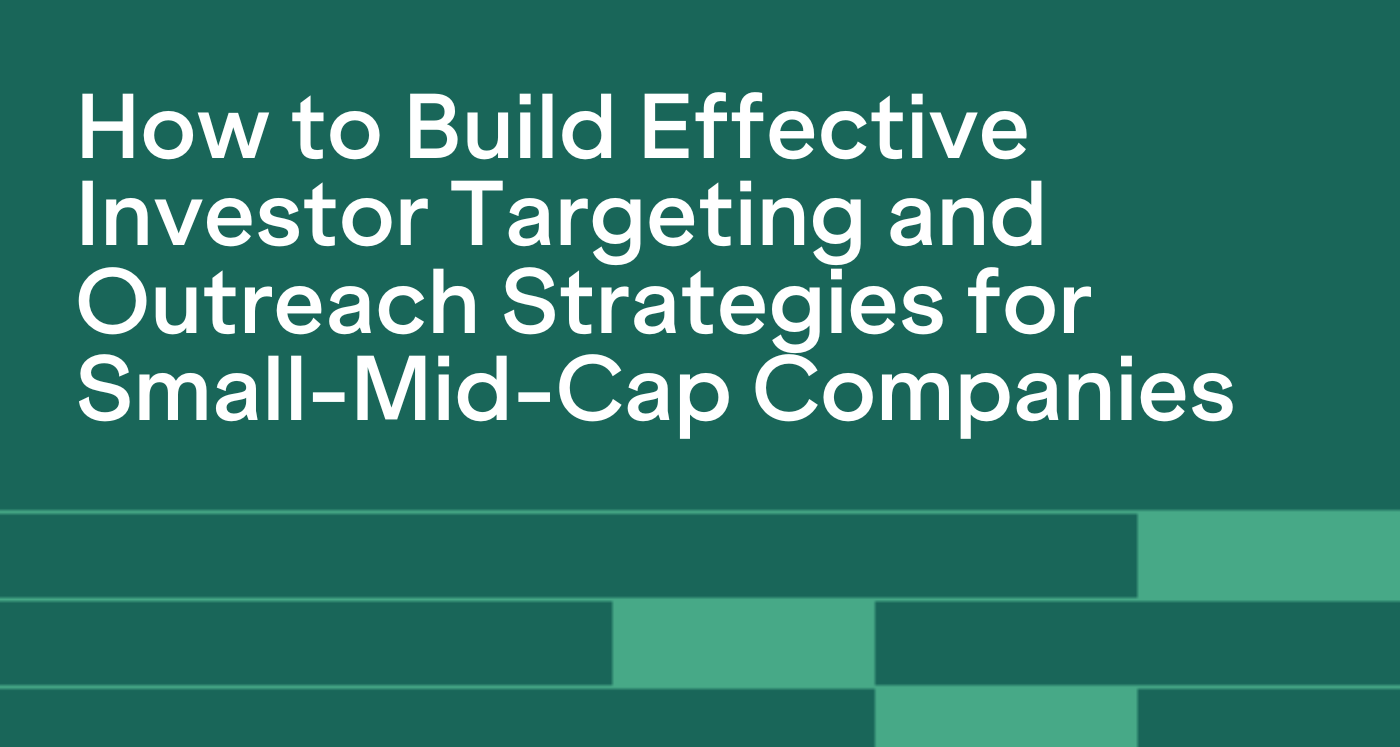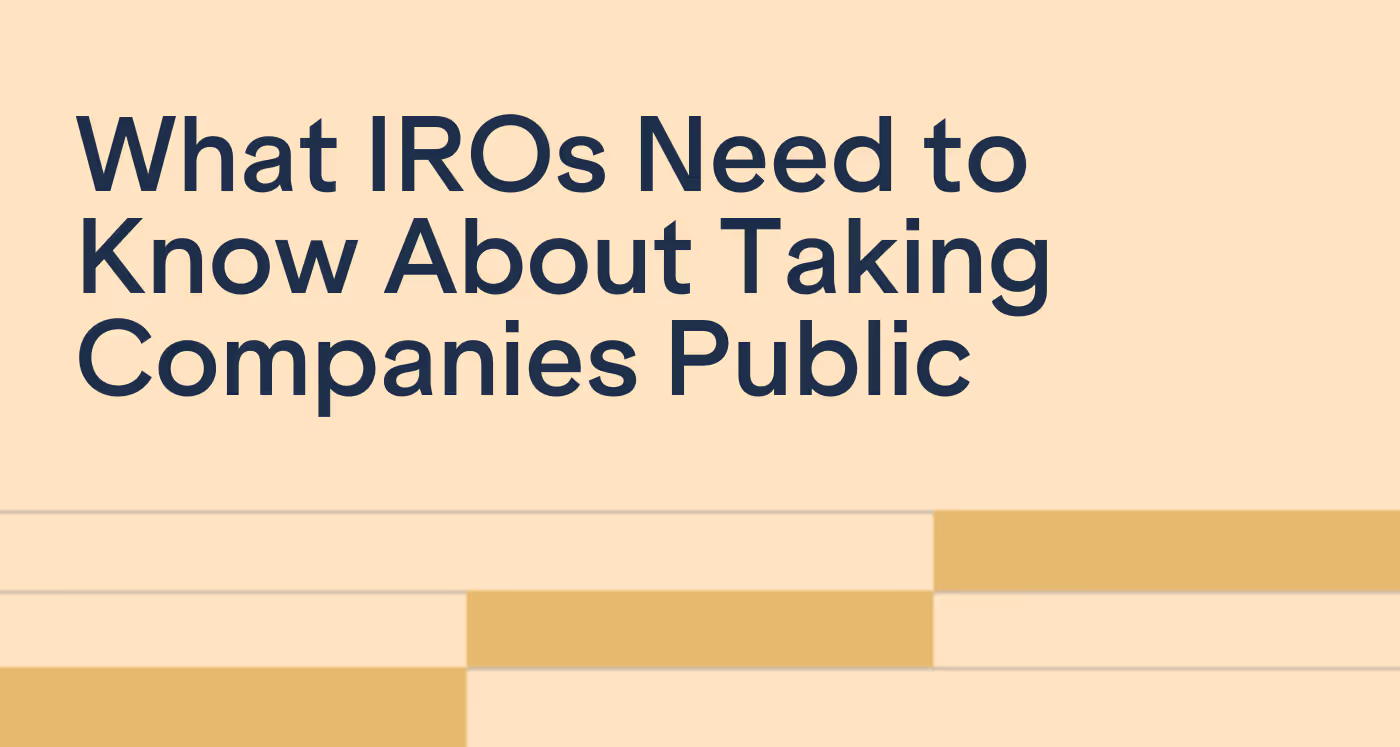
How to Build Effective Investor Targeting and Outreach Strategies for Small-Mid-Cap Companies
Learn how seasoned IR veterans are executing targeting strategies for small-mid-cap companies.

One of the most common themes that we hear from IR professionals is the challenge around measuring the impact of their investor relations. IRO’s are asking the same questions: “How do I prove the value of what I'm doing?” “How do I measure the ROI?” “How do I communicate this back to management?”
We interviewed a panel of industry experts to discuss measuring performance and how to prove IR's value to management in a webinar hosted by the National Investor Relations Institute (NIRI) and moderated by Mark Fasken, Co-Founder and COO of Irwin.
Steven Rubis, Vice President of Investor Relations, SOC Telemed.
Alex Jorgensen, Senior Vice President, Head of Investor Relations, Prosek Partners.
Charlie Schumacher, Director of Corporate Communications, Marathon Digital Holdings.
The panel breaks down examples of qualitative & quantitative metrics to track when analyzing the success of your IR efforts.
Quantitative metrics are easier to track using measurable numbers. Prosek Partners prioritizes:
Alex suggests IROs should measure activities quarterly to answer to the board and get the answer to your team. “We measure a lot of mile markers along the way, but we always try to look at it with a long-term perspective in mind.”
As an IRO it's important to nail down your company narrative and to make sure that it's well-received by investors. Qualitative metrics are often more subjective and harder to track.
Alex suggests focusing on awareness, which he measures through hearing investors repeat the narrative back to them.
Steve shares his “north star” in evaluating overall performance, which is looking through the proxy. The key quantitative metric is to look at the percentage of your shareholder base you’ve interacted with during the year.
Steve’s key qualitative performance indicators include:
Your relationship can make how you advise the executive team more clear. For example, “Do they come to you or do they call you up and say, what's going on with the stock today? Or, what do you think about this? That's a good way to understand your impact internally.”
Managing your external communications is about having the right tools and infrastructure internally in place.
“If you don't have tools like Irwin that can provide you with the background information on investors or ways to estimate share positions… You're sort of a boat that's dead in the water and can't do a lot of analysis.”

Charlie explains what Marathon looks at in terms of quantitative metrics:
One of the largest indicators of success is through Marathon’s change in institutional ownership: “On a year over year basis, from Q3 of last year to Q3 of this year, we went from 3% institutional holdings to 35 - 40%. Seeing that change, and how drastic it was for me, was a really solid proof point that people actually get our story and that they are paying attention to us.”
Marathon is proactive in their outbound efforts by building awareness and effectively communicating a story that resonates with institutional investors. A combination of their effective story and the increase in popularity of bitcoin has resulted in a great deal of inbound investors for Marathon, which is another trackable performance indicator.
Tracking conversations and trends play a large part in maintaining that qualitative element for measuring success. Being able to reference past meetings and investor profiles gives you an understanding of whether you've met with the person before and the quality of your relationship.
Alex shares the importance of leveraging a CRM tool: “CRM is invaluable, especially if you've been public for a few years. The idea that you're going to remember an investor you met at your roadshow from your secondary offering three years ago, when you were in 12 meetings, is impossible. You need a tool that’s going to be your eyes and ears and be that prompt.”
Charlie added, “Marathon works with Irwin, and what's been a beneficial value add is the background information that we get out of the system. You never want to go into a meeting and not know who you're speaking to. Worst case scenario is you don't understand what the investor’s perspective is that they're looking for, and you end up telling your narrative from a position that doesn't resonate with them. It’s very helpful to understand, is this more of a value investor? Is this more of a growth investor? Does this fund have a heavy ESG practice? How do we tailor our narrative to that?"
"Having that information in advance and understanding how you can curate or tailor your narrative to fit what the investor is looking for is your key to success.”

Misalignment between the goals of the management team and the goals of the IR team is a common problem. There is a quantity vs. quality debate in setting meeting targets for new and existing investors.
Alex explains that not every meeting is equal: “When you're in meetings, you get the sense of, is this a quality meeting? Where's my management team experiencing pain points? Where's my CEO tripping up in explaining the story? What are the questions that I'm hearing? That's really the qualitative piece that you need to be able to correct and bring to the table in addition to the meetings now.”
More meetings do not always mean more value, and it’s on the IR team to educate management on why. It’s not beneficial to overanalyze the number of meetings, but it's important to be present, understand which ones matter, and execute those presentations effectively.
“It's a billion-dollar industry to be a presentation coach…to help people. So if you can make that a part of your job as an investor relations officer, I think it's a huge value addition to your management team.”
Charlie added, “It’s critical to make sure that the investors’ and management’s expectations of execution align. It's simple in principle, but it can be challenging in practice. It comes down to integrity - do what you say you're going to do and if you're executing well, and people still don't understand what you're doing, then that's where investor relations can be very helpful to bridge that gap.”

Every six months, Alex analyzes the quality of investor meetings and the value of conferences to understand which meetings are not worth having in the future so that they’re not sending the CEO to a meeting with the same investor three quarters in a row.
Being proactive is crucial. Set your list of people you want to target, and as the business evolves, make sure that list evolves with it. Using IR software can help you track and analyze interactions and target new investors.
Learn how to evaluate the value of your IR software

Learn how seasoned IR veterans are executing targeting strategies for small-mid-cap companies.

Elizabeth Librizzi breaks down the secrets of buy-side corporate access to help investor relations professionals utilize buy-side firms.

What IROs Need to Know About Taking Companies Public: Insights from award winning investor relations thought leader Catherine Buan.